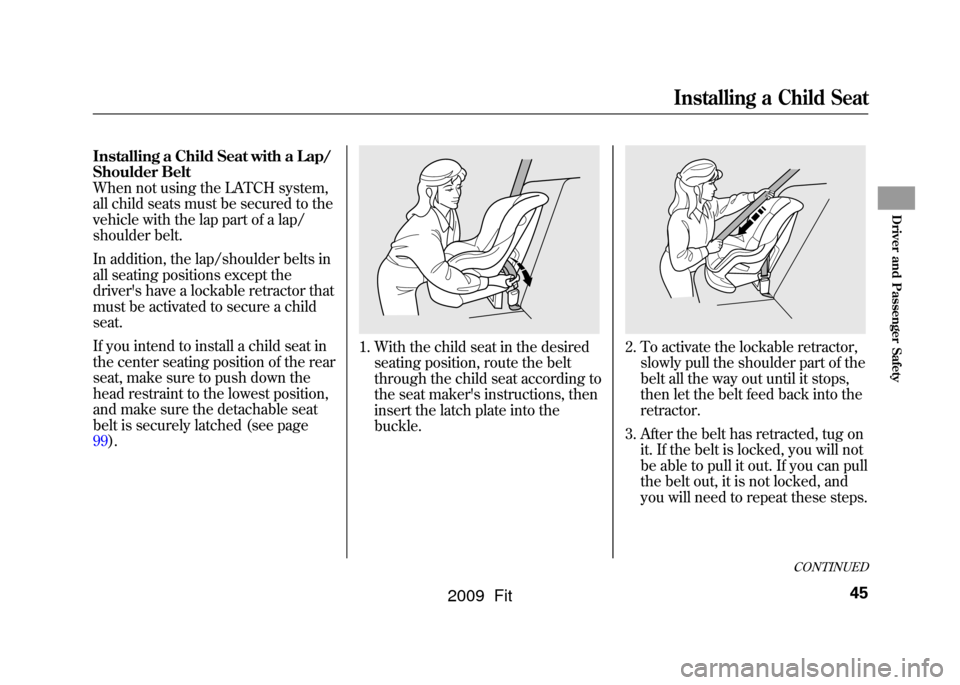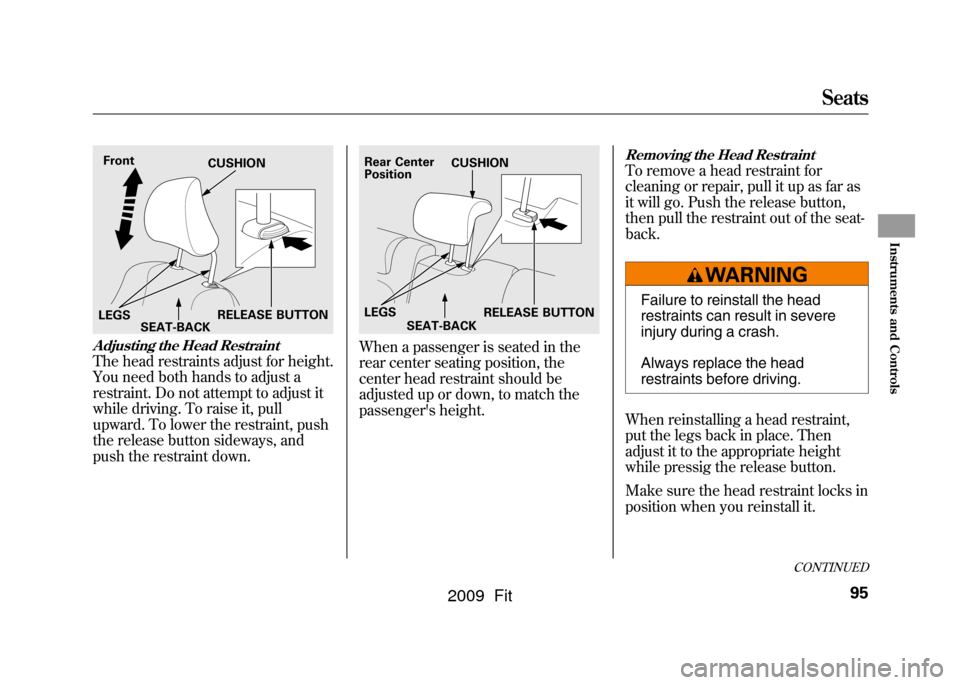Page 47 of 352
Other LATCH-compatible seats
have a flexible-type connector as
shown above.
4. Whatever type you have, follow the child seat maker's instructions for
adjusting or tightening the fit.
5. Lift the head restraint (see page94),then route the tether strap
through the legs of the head
restraint and over the seat-back,
making sure the strap is not
twisted.
6. Attach the tether strap hook to theanchor, then tighten the strap as
instructed by the child seat maker.
7. Push and pull the child seat forward and from side-to-side to
verify that it is secure.
Flexible type
ANCHOR
TETHER STRAP HOOK
Installing a Child Seat44
2009 Fit
Page 48 of 352

Installing a Child Seat with a Lap/
Shoulder Belt
When not using the LATCH system,
all child seats must be secured to the
vehicle with the lap part of a lap/
shoulder belt.
In addition, the lap/shoulder belts in
all seating positions except the
driver's have a lockable retractor that
must be activated to secure a child
seat.
If you intend to install a child seat in
the center seating position of the rear
seat, make sure to push down the
head restraint to the lowest position,
and make sure the detachable seat
belt is securely latched (see page
99).
1. With the child seat in the desiredseating position, route the belt
through the child seat according to
the seat maker's instructions, then
insert the latch plate into the
buckle.
2. To activate the lockable retractor,slowly pull the shoulder part of the
belt all the way out until it stops,
then let the belt feed back into the
retractor.
3. After the belt has retracted, tug on it. If the belt is locked, you will not
be able to pull it out. If you can pull
the belt out, it is not locked, and
you will need to repeat these steps.
CONTINUED
Installing a Child Seat
45
Driver and Passenger Safety
2009 Fit
Page 53 of 352

3. Does the shoulder belt crossbetween the child's neck and arm?
4. Is the lap part of the belt as low as possible, touching the child's
thighs?
5. Will the child be able to stay seated like this for the whole trip?
If you answer yes to all these
questions, the child is ready to wear
the lap/shoulder belt correctly. If
you answer no to any question, the
child needs to ride on a booster seat. Using a Booster Seat
A child who has outgrown a forward-
facing child seat should ride in a
back seat and use a booster seat until
the lap/shoulder belt fits them
properly without the booster.Some states and Canadian provinces
also require children to use a booster
seat until they reach a given age or
weight (e.g., 6 years or 60 lbs). Be
sure to check current laws in the
states or provinces where you intend
to drive.
Booster seats can be high-back or
low-back. Whichever style you select,
make sure the booster seat meets
federal safety standards (see page
35)and that you follow the booster
seat maker's instructions.
Protecting Larger Children50
2009 Fit
Page 60 of 352

This section gives information about
the controls and displays that
contribute to the daily operation of
your vehicle. All the essential
controls are within easy reach.Control Locations
..........................
58
Instrument Panel
..........................
59
Instrument Panel Indicators
..........
60
Gauges
..........................................
68
Trip Meter
................................
69
Current Fuel Mileage
................
70
Average Fuel Mileage
...............
70
Odometer
..................................
70
Fuel Gauge
...............................
70
Check Fuel Cap Indicator
.........
70
Maintenance Minder
................
71
Controls Near the Steering
Wheel
.......................................
72
Windshield Wipers and Washers
................................
73
Windshield Wipers
...................
73
Rear Window Wiper and
Washer
.................................
73
Turn Signal and Headlights
..........
74
Headlights
....................................
75
Instrument Panel Brightness
........
76
Hazard Warning Button
................
76
Rear Window Defogger
.................
76
Steering Wheel Adjustment
..........
77
Keys and Locks
.............................
78 Immobilizer System
......................
79
Ignition Switch
..............................
80
Door Locks
...................................
81
Power Door Locks
....................
81
Childproof Door Locks
..............
82
Auto Door Locking/
Unlocking
.............................
83
Auto Door Locking
...................
83
Auto Door Unlocking
................
85
Tailgate
.........................................
88
Remote Transmitter
......................
90
Seats
.............................................
93
Power Windows
..........................
100
Mirrors
.......................................
101
Parking Brake
.............................
102
Interior Convenience Items
.........
104
Lower Glove Box
....................
105
Upper Glove Box
.....................
105
Beverage Holders
...................
106
Seat Under Box
.......................
106
Accessory Power Socket
.........
106
Sun Visor
................................
106
Interior Lights
.............................
107
Instruments and Controls
57
Instruments and Controls
2009 Fit
Page 96 of 352
Front Seat AdjustmentsSee pages11 -12for important safety
information and warnings about how to properly position the seats and seat-
backs.Make all seat adjustments before you
start driving.
To adjust the seat forward or
backward, pull up on the bar under
the seat cushion ’s front edge. Move
the seat to the desired position, and
release the bar. Try to move the seat
to make sure it is locked in position.
To change the seat-back angle, pull
up the lever on the outside of the
seat bottom.
Once a seat is adjusted correctly,
rock it back and forth to make sure it
is locked in position.
CONTINUED
Seats
93
Instruments and Controls
2009 Fit
Page 97 of 352
ArmrestOn Sport model and Canadian LX modelThe driver's seat has an armrest on
the side of the seat-back. To use,
pivot it down.Rear Seat Adjustments
You can adjust the angle of the rear
seat-backs separately. To change the
seat-back angle, pull up the release
lever on the outer side of the seat-
back.Head Restraints
See
page 13for important safety
information and a warning about improperly positioning head restraints.Your vehicle is equipped with head
restraints in all seating positions to
help protect you and your
passengers from whiplash and other
injuries.They are most effective when you
adjust them so the center of the back
of the occupant's head rests against
the center of the restraint.
RELEASE LEVER
Seats94
2009 Fit
Page 98 of 352

Adjusting the Head RestraintThe head restraints adjust for height.
You need both hands to adjust a
restraint. Do not attempt to adjust it
while driving. To raise it, pull
upward. To lower the restraint, push
the release button sideways, and
push the restraint down.
When a passenger is seated in the
rear center seating position, the
center head restraint should be
adjusted up or down, to match the
passenger's height.
Removing the Head RestraintTo remove a head restraint for
cleaning or repair, pull it up as far as
it will go. Push the release button,
then pull the restraint out of the seat-
back.
Failure to reinstall the head
restraints can result in severe
injury during a crash.
Always replace the head
restraints before driving.
When reinstalling a head restraint,
put the legs back in place. Then
adjust it to the appropriate height
while pressig the release button.
Make sure the head restraint locks in
position when you reinstall it.
Front
RELEASE BUTTON
CUSHION
LEGS SEAT-BACK
Rear Center
Position
RELEASE BUTTON
CUSHION
LEGS SEAT-BACK
CONTINUED
Seats
95
Instruments and Controls
2009 Fit
Page 99 of 352
Active Head RestraintsThe driver's and front passenger's
seats have active head restraints. If the
vehicle is struck severely from the rear,
the occupant properly secured with the
seat belt will be pushed against the
seat-back and the head restraint will
automatically move forward.
This reduces the distance between the
restraint and the occupant’s head. It
also helps protect the occupants
against whiplash and injuries to the
neck and upper spine. After a collision, the activated restraint
should return to its normal position.
If the restraints do not return to their
normal position, or in the event of a
severe collision, have the vehicle
inspected by a Honda dealer.
For a head restraint system to work
properly:●Do not hang any items on the head
restraints, or from the restraint
legs.●Do not place any object between
an occupant and the seat-back.●Install each restraint in its proper
location.●Only use genuine Honda
replacement head restraints.
Seats96
2009 Fit